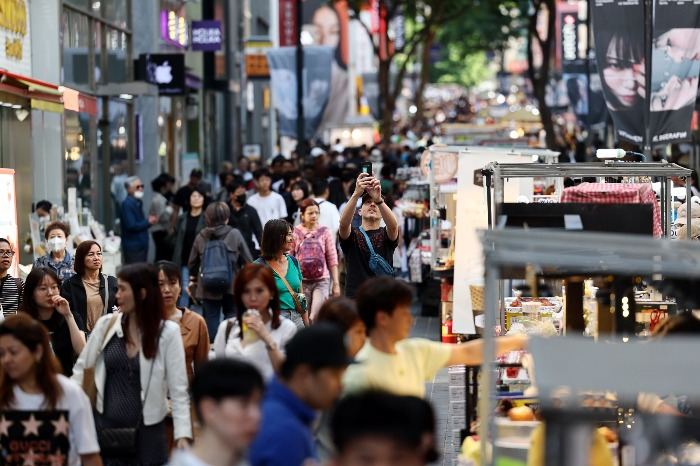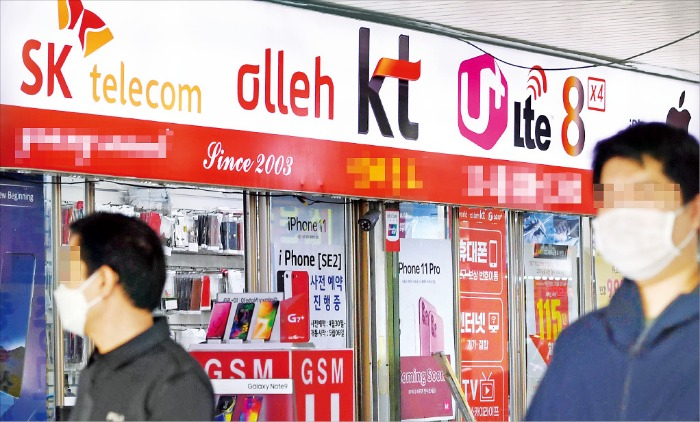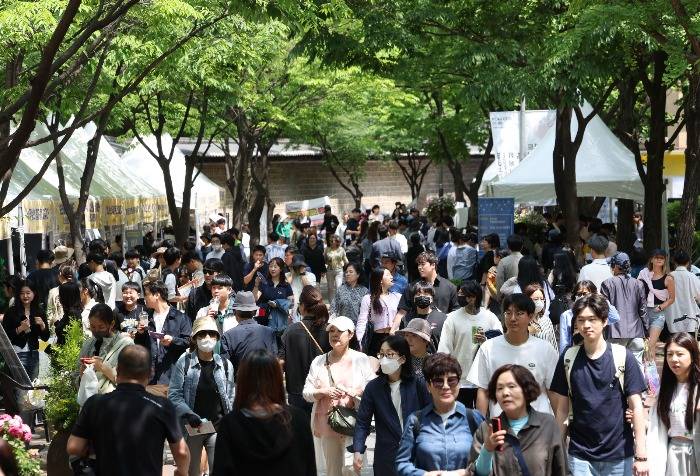Retail
SE Asian visitors revive Seoul’s tourism industry
SE Asians are expected to remain major travelers amid diplomatic tensions between South Korea and China
By May 15, 2023 (Gmt+09:00)
3
Min read
Most Read
LG Chem to sell water filter business to Glenwood PE for $692 million


KT&G eyes overseas M&A after rejecting activist fund's offer


Kyobo Life poised to buy Japan’s SBI Group-owned savings bank


StockX in merger talks with Naver’s online reseller Kream


Meritz backs half of ex-manager’s $210 mn hedge fund



In Myeongdong, Seoul’s shopping mecca, on May 14, street vendors were busy soliciting foreign tourists, greeting them in their mother tongues from Thai to Vietnamese and Arabic.
“Southeast Asian shoppers had hesitated to open their wallets for over 30,000 won ($22.5) before,” said a store employee in the shopping hub. “Now they show no hesitation to snap something for 50,000 won.”
This illustrates the changed landscape of South Korea’s tourism industry, which had relied heavily on Chinese visitors.
In the first quarter of this year, inbound travelers from Vietnam, the Philippines, Thailand, Malaysia, Singapore and Indonesia reached a combined 277,624, more than quintuple those from China, according to the Korea Culture and Tourism Institute.
Including visitors from other Southeast Asian countries, the gap widened further.
In quick response to such trends, some street vendors displayed their items on stalls with brief accounts in Vietnamese and Thai languages.
Missha, a low-price Korean cosmetics brand, set up a compartment dedicated to Southeast Asian customers within its shop in Myeongdong to exhibit their favorite skincare products and foundation creams.
Another budget skincare brand Nature Republic hires Southeast Asians studying in Korea to serve customers from their homeland. Its Myeongdong store was located on land ranked as South Korea’s most expensive property for the past two years in a row.
Some Korean restaurants began to offer halal food, or no-pork dishes, on the streets of Myeongdong. A 40-seat halal food restaurant on a narrow alley of the shopping district was more than half full even after lunchtime.
Muslims account for about 40% of the Southeast Asian population of 660 million.

Electronics stores are among the beneficiaries of the rise in Southeast Asian travelers. At I’Park Mall in Yongsan in downtown Seoul, about half of the 15 secondhand electronics stores recruited Southeast Asians to better serve those from their countries.
Secondhand handsets from Samsung’s budget Galaxy lines, priced between 100,000 and 200,000, are the most popular among travelers. For souvenirs, they pick high-end iPhone smartphones priced at 500,000 won or above, according to one salesperson.
Nguyen Thi Thuy, a Vietnamese employee of a used electronics goods store in Yongsan, said that secondhand handsets sold in South Korea are about 20% cheaper with better quality than those available in his home country.
In 2022, Vietnamese tourists splurged the most among foreign visitors to South Korea, according to Korean credit card and financial service company BC Card Co.
The eased COVID-19 restrictions and an improved visa process led to the rapid increase of foreign visitors.
In 2021, tourists from major Southeast Asian countries reached 60,278, more than the 14,824 from China.
It is the first time that Southeast Asian visitors topped Chinese travelers since the outbreak of COVID-19 in 2020.

The tourism industry observers welcomed the diversification in the pool of foreign visitors, but said the industry has yet to make a full-fledged recovery until the number of Chinese travelers rebounds to pre-pandemic levels.
Chinese tourists to Korea tend to spend about twice as much as those from other countries.
According to the Ministry of Culture, Sports and Tourism, Chinese visitors spent an average of $1,632.6 during their stay in South Korea in 2019, followed by Filipinos’ $807.5, Thais’ $946.3 and Malaysians’ $946.7.
For some time, Southeast Asians are expected to continue to take up a big chunk of inbound travelers to South Korea.
“The tourism industry is affected greatly by diplomatic relationships and government policy,” said Chung Ran-soo, a professor at Hanyang University’s tourism department.
“The tensions between the two countries over Taiwan stirred up anti-Korea sentiment within China. This could lead to a second round of measures against South Korea.”
He refers to China’s restrictions of imports from South Korea and ban on group tours to the country imposed in 2016 in retaliation for Seoul’s decision to deploy a US Terminal High Altitude Area Defense System.
Write to Jeong-Hoon An at ajh6321@hankyung.com
Yeonhee Kim edited this article.
More to Read
-
 COVID-19Korea to lift most COVID-19 rules with lower crisis level
COVID-19Korea to lift most COVID-19 rules with lower crisis levelMay 11, 2023 (Gmt+09:00)
1 Min read -
 Travel & LeisureVietnamese tourists top in card spending in Korea in 2022
Travel & LeisureVietnamese tourists top in card spending in Korea in 2022May 03, 2023 (Gmt+09:00)
3 Min read -
 Travel & LeisureTourist arrival gap between S.Korea, Japan widens sharply
Travel & LeisureTourist arrival gap between S.Korea, Japan widens sharplyMar 10, 2023 (Gmt+09:00)
1 Min read
Comment 0
LOG IN


